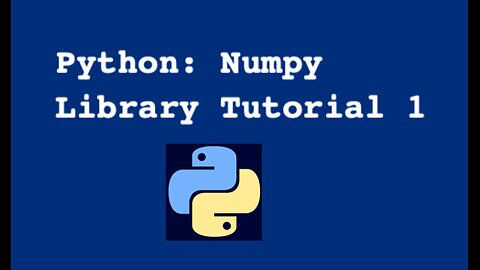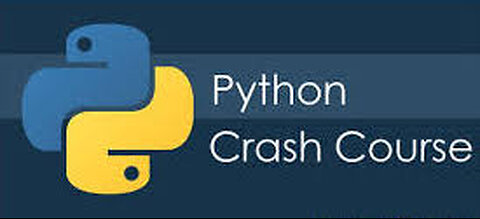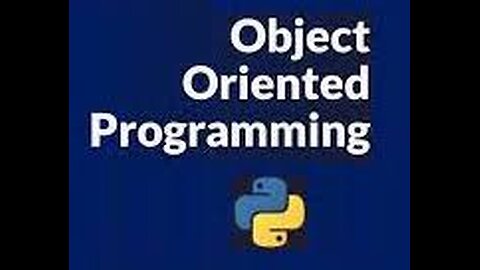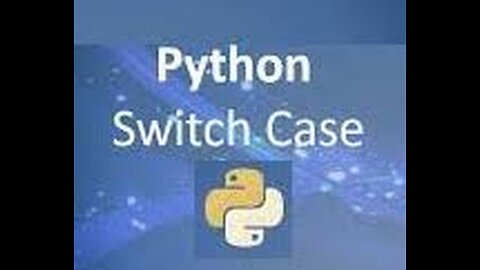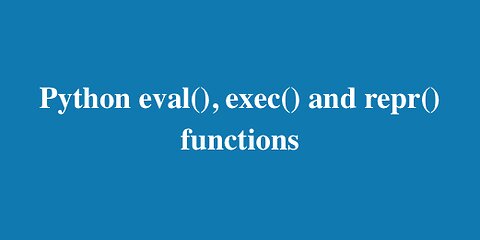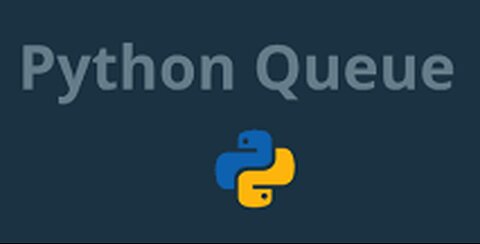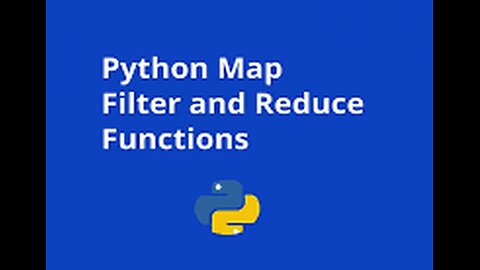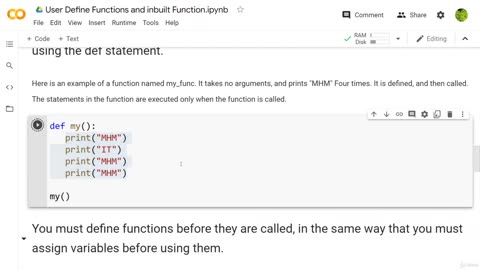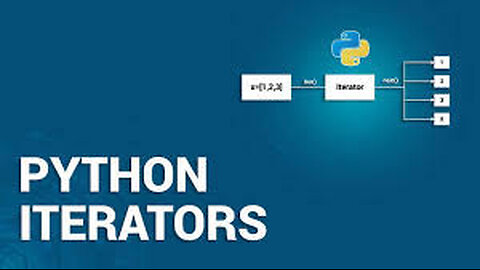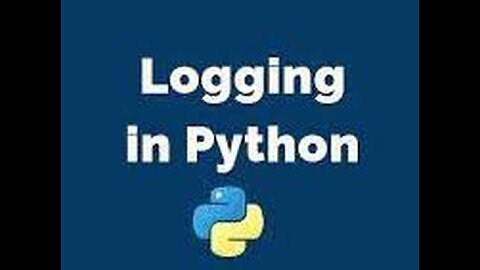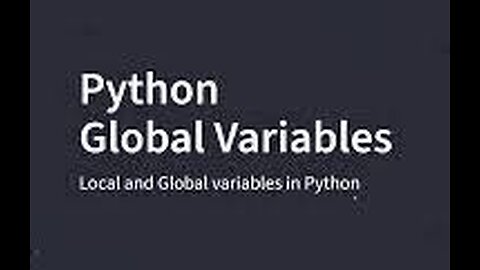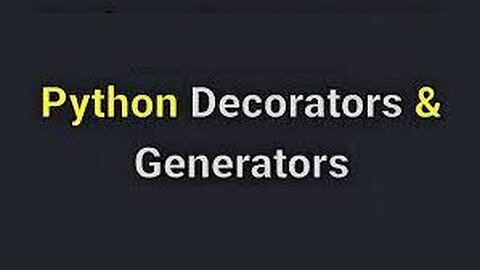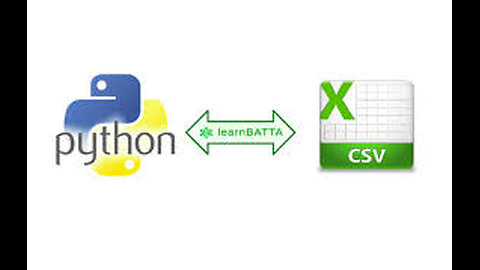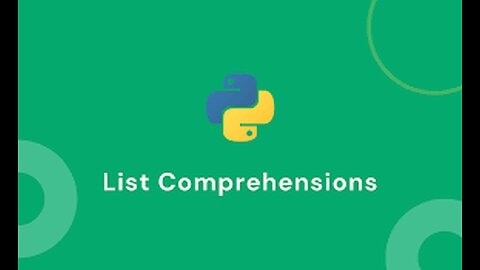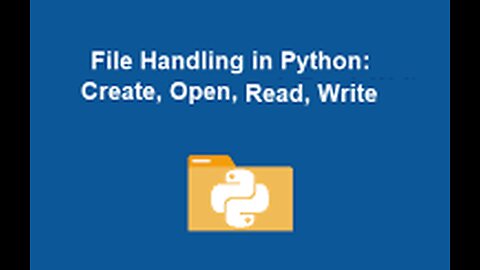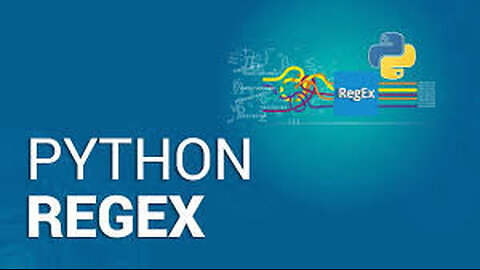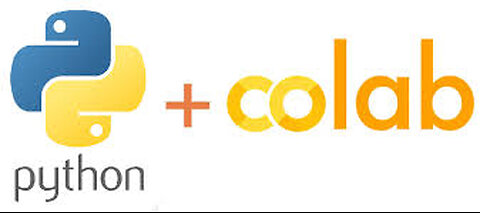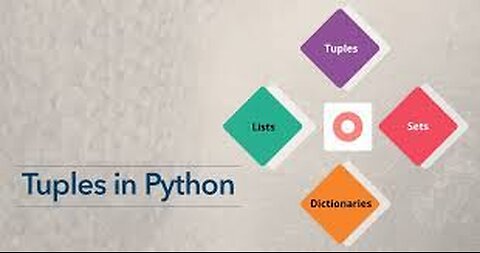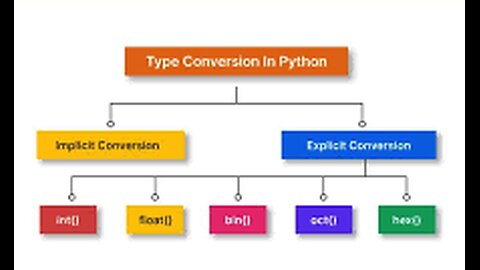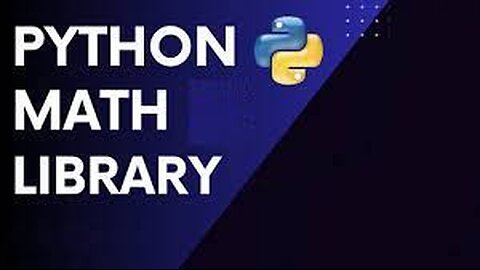Premium Only Content
This video is only available to Rumble Premium subscribers. Subscribe to
enjoy exclusive content and ad-free viewing.
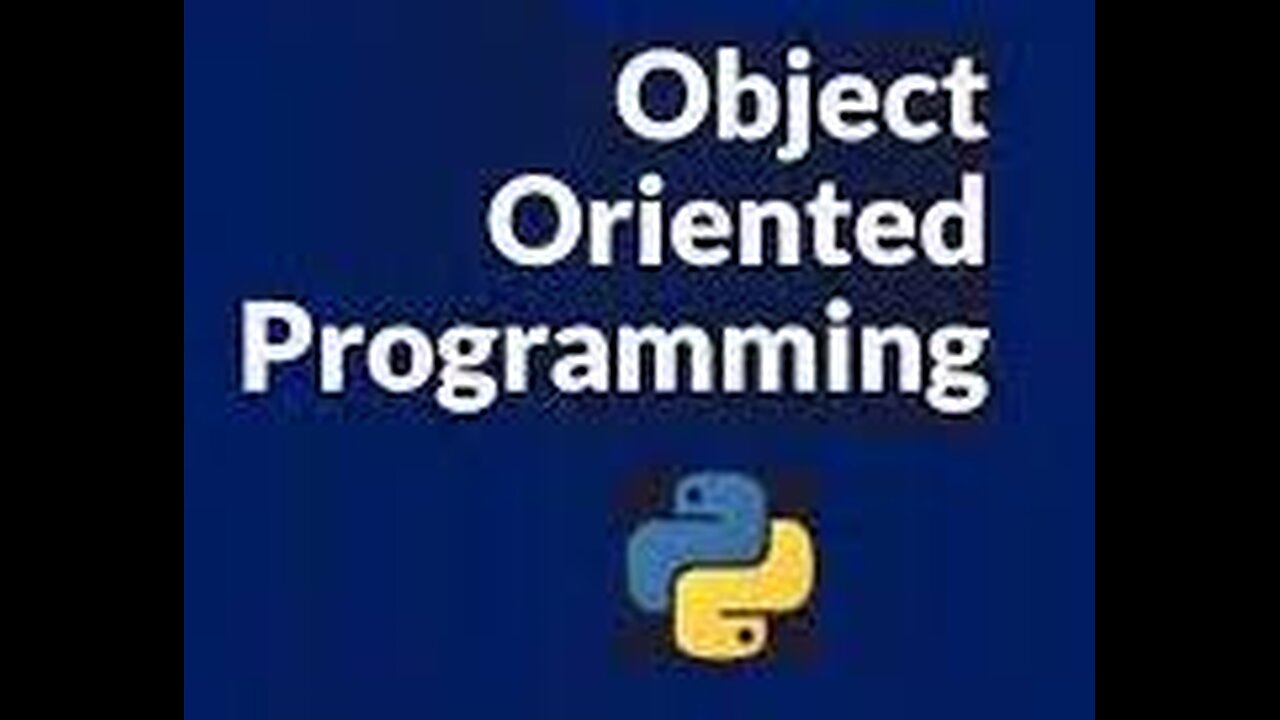
Python Programming
TechnoGate
- 3 / 36
1
37. Python: NumPy Library Tutorial (1)
Python Beyond Basics for Machine Learning, Data Science, AI
NumPy is an open source mathematical and scientific computing library for Python programming tasks. The name NumPy is shorthand for Numerical Python. The NumPy library offers a collection of high-level mathematical functions including support for multi-dimensional arrays, masked arrays and matrices.
2
36. Python Crash Course
Python Beyond Basics for Machine Learning, Data Science, AI
Overall review for Videos from 2 to 35
35. Python: Object Oriented Programming (OOP)
Python Beyond Basics for Machine Learning, Data Science, AI
Python Object-Oriented Programming (OOP) is a programming paradigm that organizes code into objects, which are instances of classes. It allows for better code reuse, modularity, and organization.
4
33. Python: Switch Case
Python Beyond Basics for Machine Learning, Data Science, AI
The switch-case statement is not a built-in feature in Python, but it can be implemented using a combination of if-elif-else statements, classes, or using a dictionary that maps the cases to its corresponding behavior.
5
33. Python: eval(),exec(),repr() function
Python Beyond Basics for Machine Learning, Data Science, AI
* The eval() function evaluates the specified expression, if the expression is a legal Python statement, it will be executed.
* The exec() function executes the specified Python code. The exec() function accepts large blocks of code, unlike the eval() function which only accepts a single expression.
* The repr() function returns a string containing a printable representation of an object.
1
comment
6
31. Python: isinstance, Use of format, Timeit, round, Slice and abs
Python Beyond Basics for Machine Learning, Data Science, AI
1. isinstance() function returns True if the specified object is of the specified type, otherwise False. If the type parameter is a tuple, this function will return True if the object is one of the types in the tuple.
2. format() method formats the specified value(s) and insert them inside the string's placeholder. The placeholder is defined using curly brackets: {}. Read more about the placeholders in the Placeholder section below. format() method returns the formatted string.
3. timeit() method measure execution time of small code snippets. This module provides a simple way to time small bits of Python code.
4. round() function returns a floating point number that is a rounded version of the specified number, with the specified number of decimals. The default number of decimals is 0, meaning that the function will return the nearest integer.
5. slice() function returns a slice object. A slice object is used to specify how to slice a sequence. You can specify where to start the slicing, and where to end. You can also specify the step, which allows you to e.g. slice only every other item.
6. abs() function returns the absolute value of the specified number.
1
comment
7
30. Python Queue
Python Beyond Basics for Machine Learning, Data Science, AI
It is an in-built module for implementing a queue in Python. You can use different functions available in the module to perform operations on a queue. Below is an example of implementing a queue with the help of a queue, along with the use of different functions.
1
comment
8
29. Python: Lambda, Map, Filter and Reduce Function.
Python Beyond Basics for Machine Learning, Data Science, AI
To work with map(), the lambda should have one parameter in, representing one element from the source list. Choose a suitable name for the parameter, like n for a list of numbers, s for a list of strings. The result of map() is an "iterable" map object which mostly works like a list, but it does not print.
9
24. Python: User-defined functions and Inbuilt functions
Python Beyond Basics for Machine Learning, Data Science, AI
If you define the function yourself, it is a user-defined function. On the other hand, the Python function that come along with Python are known as in-built functions. All the functions apart from in-built functions and library functions come under the category of user-defined functions.
10
25. Python: iterator
Python Beyond Basics for Machine Learning, Data Science, AI
An iterator is an object that contains a countable number of values.
An iterator is an object that can be iterated upon, meaning that you can traverse through all the values.
Technically, in Python, an iterator is an object which implements the iterator protocol, which consist of the methods __iter__() and __next__().
11
28. Python Logging Module
Python Beyond Basics for Machine Learning, Data Science, AI
Python logging is a module that allows you to track events that occur while your program is running. You can use logging to record information about errors, warnings, and other events that occur during program execution. And logging is a useful tool for debugging, troubleshooting, and monitoring your program.
12
27. Python: Global and local Variables in Functions.
Python Beyond Basics for Machine Learning, Data Science, AI
Local variables exist only during the function's executions, while global variables remain in memory for the duration of the program. Local variables can be accessed only within the function or block where it is defined, whereas global variables are accessed throughout the entire program.
1
comment
13
26. Python: Generator and decorators.
Python Beyond Basics for Machine Learning, Data Science, AI
Decorators and generators are powerful concepts in Python that enhance code reusability, readability, and performance. Decorators let you add functionality before and/or after function execution dynamically, while generators enable the generation of sequence values on the fly instead of loading them all at once.
14
23. Python CSV file Operations
Python Beyond Basics for Machine Learning, Data Science, AI
Reading from a CSV file is done using the reader object. The CSV file is opened as a text file with Python's built-in open() function, which returns a file object. This is then passed to the reader , which does the heavy lifting.
15
22. Python: List Comprehension, Frozensets and Assertion
Python Beyond Basics for Machine Learning, Data Science, AI
* List comprehension offers a shorter syntax when you want to create a new list based on the values of an existing list.
* Frozen set is just an immutable version of a Python set object. While elements of a set can be modified at any time, elements of the frozen set remain the same after creation.
* The assert keyword lets you test if a condition in your code returns True, if not, the program will raise an AssertionError.
16
18. Python: Create, Edit, Write, Read Text File
Python Beyond Basics for Machine Learning, Data Science, AI
open() function is used to open the file in write mode. It is similar to the built-in open() function but provides additional options, such as specifying the encoding. The file is created with the specified text, and the success message is printed. import io # Using io.
17
19. Python: Exception Handling
Python Beyond Basics for Machine Learning, Data Science, AI
Exception handling in Python is a process of resolving errors that occur in a program. This involves catching exceptions, understanding what caused them, and then responding accordingly. Exceptions are errors that occur at runtime when the program is being executed.
18
21. Python: Regular Expression (RegEx)
Python Beyond Basics for Machine Learning, Data Science, AI
A RegEx, or Regular Expression, is a sequence of characters that forms a search pattern.
RegEx can be used to check if a string contains the specified search pattern.
2
comments
19
20. Python: Collection Module
Python Beyond Basics for Machine Learning, Data Science, AI
The collection Module in Python provides different types of containers. A Container is an object that is used to store different objects and provide a way to access the contained objects and iterate over them. Some of the built-in containers are Tuple, List, Dictionary, etc. In this article, we will discuss the different containers provided by the collections module.
20
1. Set Up Environment Google Colab
Python Beyond Basics for Machine Learning, Data Science, AI
Colab is a hosted Jupyter Notebook service that requires no setup to use and provides free of charge access to computing resources, including GPUs and TPUs. Colab is especially well suited to machine learning, data science, and education. Yes. Colab is free of charge to use.
https://colab.research.google.com
21
2. Python: Data Type and Variable, Keywords
Python Beyond Basics for Machine Learning, Data Science, AI
Built-in Data Types In programming, data type is an important concept. Variables can store data of different types, and different types can do different things.
22
3. Python: How to take input
Python Beyond Basics for Machine Learning, Data Science, AI
Python allows for user input. That means we are able to ask the user for input. The method is a bit different in Python 3.6 than Python 2
23
4. Python: Print Statement and How to produce output
Python Beyond Basics for Machine Learning, Data Science, AI
Print Statement and How to produce output
24
5. Python: Introduction to List, Tuple, Dictionary, Set.
Python Beyond Basics for Machine Learning, Data Science, AI
A list is an ordered, mutable collection of elements. A tuple is an ordered, immutable collection of elements. A set is an unordered collection of unique elements. A dictionary is an unordered collection of key-value pairs.
25
6. Python: String Operations
Python Beyond Basics for Machine Learning, Data Science, AI
Following are the common string operations that can be performed in Python: Concatenation of two or more strings. Extracting or slicing partial strings from string values. Adding or removing spaces. Converting to lower or upper case
26
7. Python: Operators in details
Python Beyond Basics for Machine Learning, Data Science, AI
Arithmetic operator
Comparison operator
Assignment operator
Logical operator
Bitwise operator
Membership operator
Identity operator
27
8. Python: List Operations in details
Python Beyond Basics for Machine Learning, Data Science, AI
append()
clear()
copy()
count()
extend()
index()
insert()
pop()
remove()
reverse()
sort()
28
9. Python: Tuple Operations in details
Python Beyond Basics for Machine Learning, Data Science, AI
tuple() Function.
len() Function.
count() Function.
index() Function.
sorted() Function.
min() Function.
max() Function.
sum() Function.
1
comment
29
10. Python: Set Operations in details
Python Beyond Basics for Machine Learning, Data Science, AI
In Python, a set is an unordered, mutable collection of unique elements. Mathematical set operations like union, intersection, and difference can be performed on them. Two different sets can be compared with the subset, superset, and disjoint relations. The members of a set must be hashable.
30
11. Python: Dictionary Operations in details
Python Beyond Basics for Machine Learning, Data Science, AI
Python has a set of built-in methods that you can use on dictionaries.
1) clear(): Removes all the elements from the dictionary
2) copy(): Returns a copy of the dictionary
3) fromkeys(): Returns a dictionary with the specified keys and value
4) get(): Returns the value of the specified key
5) items(): Returns a list containing a tuple for each key value pair
6) keys(): Returns a list containing the dictionary's keys
7) pop(): Removes the element with the specified key
8) popitem(): Removes the last inserted key-value pair
9) setdefault(): Returns the value of the specified key. If the key does not exist: insert the key, with the specified value
10) update(): Updates the dictionary with the specified key-value pairs
11) values(): Returns a list of all the values in the dictionary
31
12. Python: Data Type Conversion
Python Beyond Basics for Machine Learning, Data Science, AI
The process of converting the value of one data type (integer, string, float, etc.) to another data type is called Type Conversion. Python has two types of type conversion. Implicit Type Conversion. Explicit Type Conversion.
32
13. Indentation in Python
Python Beyond Basics for Machine Learning, Data Science, AI
Indentation refers to the spaces at the beginning of a code line. Where in other programming languages the indentation in code is for readability only, the indentation in Python is very important. Python uses indentation to indicate a block of code.
33
14. Python: Random Number, Range Function
Python Beyond Basics for Machine Learning, Data Science, AI
The randrange() function is a built-in Python function used to generate random integers between a given start and stop value.
34
15. Python: Sequential, Selection & Repetition -for, while, break, continue, if-elif else
Python Beyond Basics for Machine Learning, Data Science, AI
Type of Loops
For Loop. A for loop in Python is used to iterate over a sequence (list, tuple, set, dictionary, and string). Flowchart: ...
While Loop. The while loop is used to execute a set of statements as long as a condition is true. ...
Nested Loop. If a loop exists inside the body of another loop, it is called a nested loop.
Type of Conditional Statements
There are 4 types of if statements: if, If else, Nested if else and If else Ladder. What is the if-else conditional structure? if else is a conditional statement, and they define conditions for their execution.
35
16. Python: Math Library
Python Beyond Basics for Machine Learning, Data Science, AI
Python has a built-in module that you can use for mathematical tasks.
The math module has a set of methods and constants.
36
17. Python: Datetime and Calendar Module
Python Beyond Basics for Machine Learning, Data Science, AI
Python date is an object that's used to represent the calendar date with no time of date, while a Python datetime object includes the date and time of day.
35. Python: Object Oriented Programming (OOP)
24 days ago
48
Python Object-Oriented Programming (OOP) is a programming paradigm that organizes code into objects, which are instances of classes. It allows for better code reuse, modularity, and organization.
Loading comments...
-
 7:32
7:32
WhaddoYouMeme
1 hour agoShe Mocked Christians—Didn’t Go as Planned!
102 -
 43:03
43:03
The White House
2 hours agoPress Secretary Karoline Leavitt Briefs Members of the Media with a Special Guest, Apr. 16, 2025
20.1K24 -
 47:12
47:12
Friday Beers
3 hours ago $0.55 earnedWho Survived Our First Game of Dungeons and Dragons? (Ft. Almost Friday TV)
6.57K -
 1:21:59
1:21:59
RiftTV/Slightly Offensive
2 hours ago $2.77 earnedDid RFK Just EXPOSE a SHOCKING REALITY About Autism? | The Rift Report
17.4K6 -
 LIVE
LIVE
LFA TV
20 hours agoLFA TV - ALL DAY LIVE STREAM 4/16/25
779 watching -
 2:16:41
2:16:41
The Quartering
4 hours agoKarmelo Anthony Buys $150,000 Cadillac, Maryland Man Psyop, Blue Origin Flight FAKED & More
140K84 -
 1:29:10
1:29:10
The Sage Steele Show
8 hours ago $3.99 earnedBen Carson | The Sage Steele Show
37.8K7 -
 1:34:58
1:34:58
The HotSeat
3 hours agoBlue Origin ‘Astronauts’ and the Left’s Love Affair with Illegals
19K -
 20:55
20:55
Bearing
10 hours agoLIKE OMG!! KATY PERRY LIKE TOTALLY JUST CONQUERED SPACE!! 😝🚀🙀
45.3K69 -
 1:07:01
1:07:01
Jeff Ahern
2 hours ago $0.61 earnedNever Woke Wednesday with Jeff Ahern
16.9K
